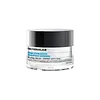What's inside
What's inside
 Key Ingredients
Key Ingredients

No key ingredients
 Benefits
Benefits

 Concerns
Concerns

 Ingredients Side-by-side
Ingredients Side-by-side

Water
Skin ConditioningGlycerin
HumectantIsodecyl Neopentanoate
EmollientEthylhexyl Palmitate
EmollientGlyceryl Dilaurate
EmollientOctyldodecyl Stearate
EmollientMyristyl Myristate
EmollientButyrospermum Parkii Butter
Skin ConditioningCetyl Alcohol
EmollientGlyceryl Stearate
EmollientPEG-75 Stearate
Butylene Glycol
HumectantCeteth-20
CleansingSteareth-20
CleansingMyristyl Laurate
Acrylates/C10-30 Alkyl Acrylate Crosspolymer
Emulsion StabilisingOryza Sativa Extract
AbsorbentDimer Tripeptide-43
Palmitoyl Oligopeptide
CleansingPalmitoyl Tetrapeptide-7
Skin ConditioningHydrolyzed Soy Protein
HumectantSorbitan Oleate
EmulsifyingSorbitan Laurate
EmulsifyingMyristyl Malate Phosphonic Acid
Skin ConditioningCarbomer
Emulsion StabilisingPolysorbate 20
EmulsifyingDisodium EDTA
Sodium Hydroxide
BufferingCitrus Aurantium Dulcis Peel Oil
MaskingCaprylyl Glycol
EmollientSorbic Acid
PreservativeSodium Benzoate
MaskingPotassium Sorbate
PreservativeLimonene
PerfumingPhenoxyethanol
PreservativeWater, Glycerin, Isodecyl Neopentanoate, Ethylhexyl Palmitate, Glyceryl Dilaurate, Octyldodecyl Stearate, Myristyl Myristate, Butyrospermum Parkii Butter, Cetyl Alcohol, Glyceryl Stearate, PEG-75 Stearate, Butylene Glycol, Ceteth-20, Steareth-20, Myristyl Laurate, Acrylates/C10-30 Alkyl Acrylate Crosspolymer, Oryza Sativa Extract, Dimer Tripeptide-43, Palmitoyl Oligopeptide, Palmitoyl Tetrapeptide-7, Hydrolyzed Soy Protein, Sorbitan Oleate, Sorbitan Laurate, Myristyl Malate Phosphonic Acid, Carbomer, Polysorbate 20, Disodium EDTA, Sodium Hydroxide, Citrus Aurantium Dulcis Peel Oil, Caprylyl Glycol, Sorbic Acid, Sodium Benzoate, Potassium Sorbate, Limonene, Phenoxyethanol
 Reviews
Reviews

Ingredients Explained
These ingredients are found in both products.
Ingredients higher up in an ingredient list are typically present in a larger amount.
Butylene Glycol (or BG) is used within cosmetic products for a few different reasons:
Overall, Butylene Glycol is a safe and well-rounded ingredient that works well with other ingredients.
Though this ingredient works well with most skin types, some people with sensitive skin may experience a reaction such as allergic rashes, closed comedones, or itchiness.
Learn more about Butylene GlycolThis ingredient is also known as shea butter. It is an effective skin hydrator and emollient.
Emollients help soothe and soften your skin. It does this by creating a protective film on your skin. This barrier helps trap moisture and keeps your skin hydrated. Emollients may be effective at treating dry or itchy skin.
Shea butter is rich in antioxidants. Antioxidants help fight free-radicals, or molecules that may harm the body. It is also full of fatty acids including stearic acid and linoleic acid. These acids help replenish the skin and keep skin moisturized.
While Shea Butter has an SPF rating of about 3-4, it is not a sunscreen replacement.
Shea butter may not be fungal acne safe. We recommend speaking with a professional if you have any concerns.
Learn more about Butyrospermum Parkii ButterWe don't have a description for Ceteth-20 yet.
Cetyl Alcohol is a fatty alcohol. Fatty Alcohols are most often used as an emollient or to thicken a product.
Its main roles are:
Though it has "alcohol" in the name, it is not related to denatured alcohol or ethyl alcohol.
The FDA allows products labeled "alcohol-free" to have fatty alcohols.
Learn more about Cetyl AlcoholGlycerin is already naturally found in your skin. It helps moisturize and protect your skin.
A study from 2016 found glycerin to be more effective as a humectant than AHAs and hyaluronic acid.
As a humectant, it helps the skin stay hydrated by pulling moisture to your skin. The low molecular weight of glycerin allows it to pull moisture into the deeper layers of your skin.
Hydrated skin improves your skin barrier; Your skin barrier helps protect against irritants and bacteria.
Glycerin has also been found to have antimicrobial and antiviral properties. Due to these properties, glycerin is often used in wound and burn treatments.
In cosmetics, glycerin is usually derived from plants such as soybean or palm. However, it can also be sourced from animals, such as tallow or animal fat.
This ingredient is organic, colorless, odorless, and non-toxic.
Glycerin is the name for this ingredient in American English. British English uses Glycerol/Glycerine.
Learn more about GlycerinGlyceryl Stearate is a mix of glycerin and stearic acid.
It is used to stabilize the mixing of water and oil ingredients. By preventing these ingredients from separating, it can help elongate shelf life. It can also help thicken the product's texture.
As an emollient, it helps soften skin and supports barrier-replenishing ingredients.
In cosmetics, Glyceryl Stearate is often made from vegetable oils or synthetically produced.
This ingredient may not be fungal-acne safe
Fun fact: The human body also creates Glyceryl Stearate naturally.
Learn more about Glyceryl StearatePEG-75 Stearate isn't fungal acne safe.
Steareth-20 is a waxy compound used to emulsify ingredients. It is created from stearyl alcohol.
It possesses surfactant properties. This means it reduces surface tension and helps oils, dirt, and pollutants to be washed away.
The 20 stands for the number of ethylene oxide used to create this ingredient.
Learn more about Steareth-20Water. It's the most common cosmetic ingredient of all. You'll usually see it at the top of ingredient lists, meaning that it makes up the largest part of the product.
So why is it so popular? Water most often acts as a solvent - this means that it helps dissolve other ingredients into the formulation.
You'll also recognize water as that liquid we all need to stay alive. If you see this, drink a glass of water. Stay hydrated!
Learn more about Water